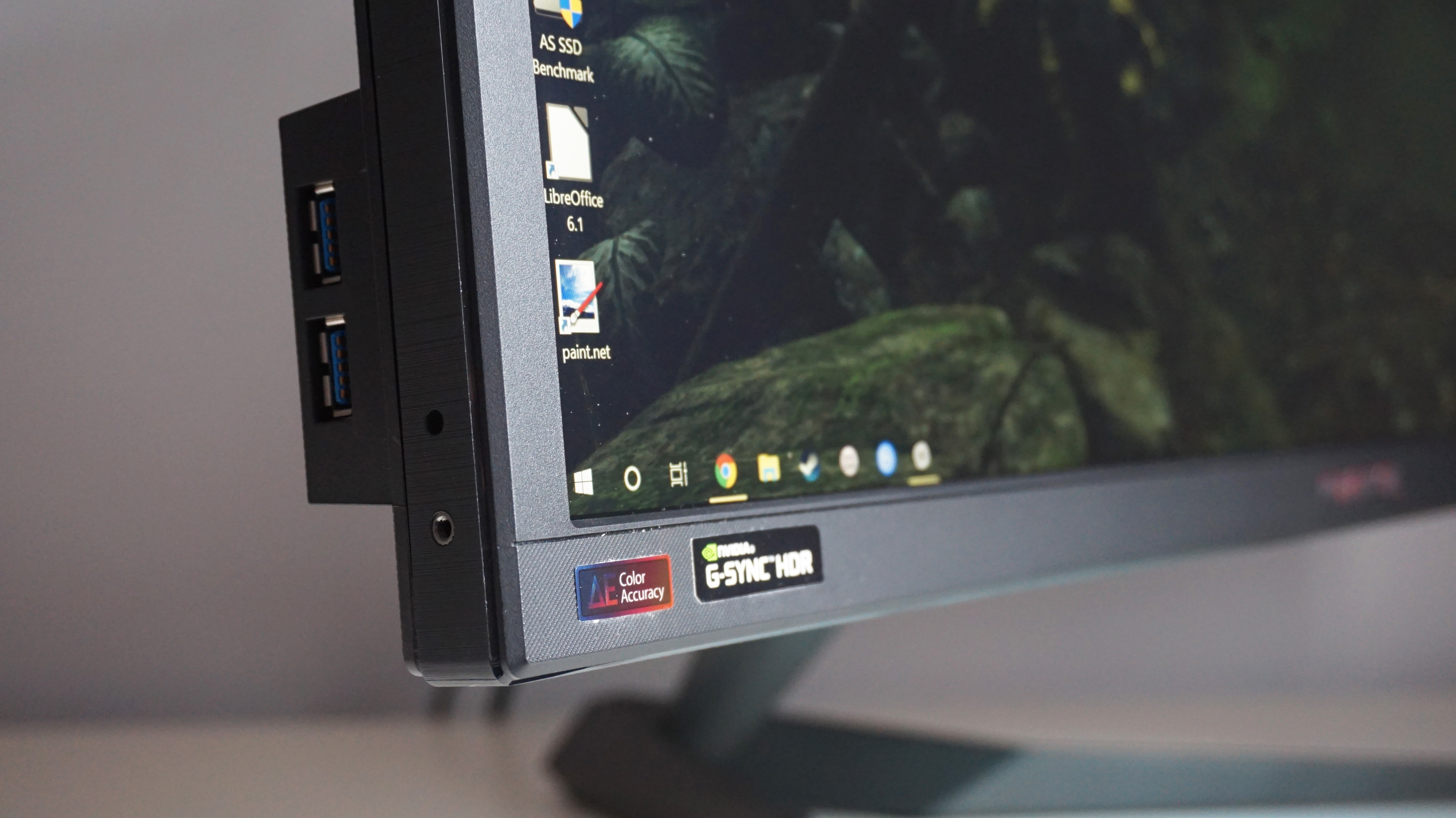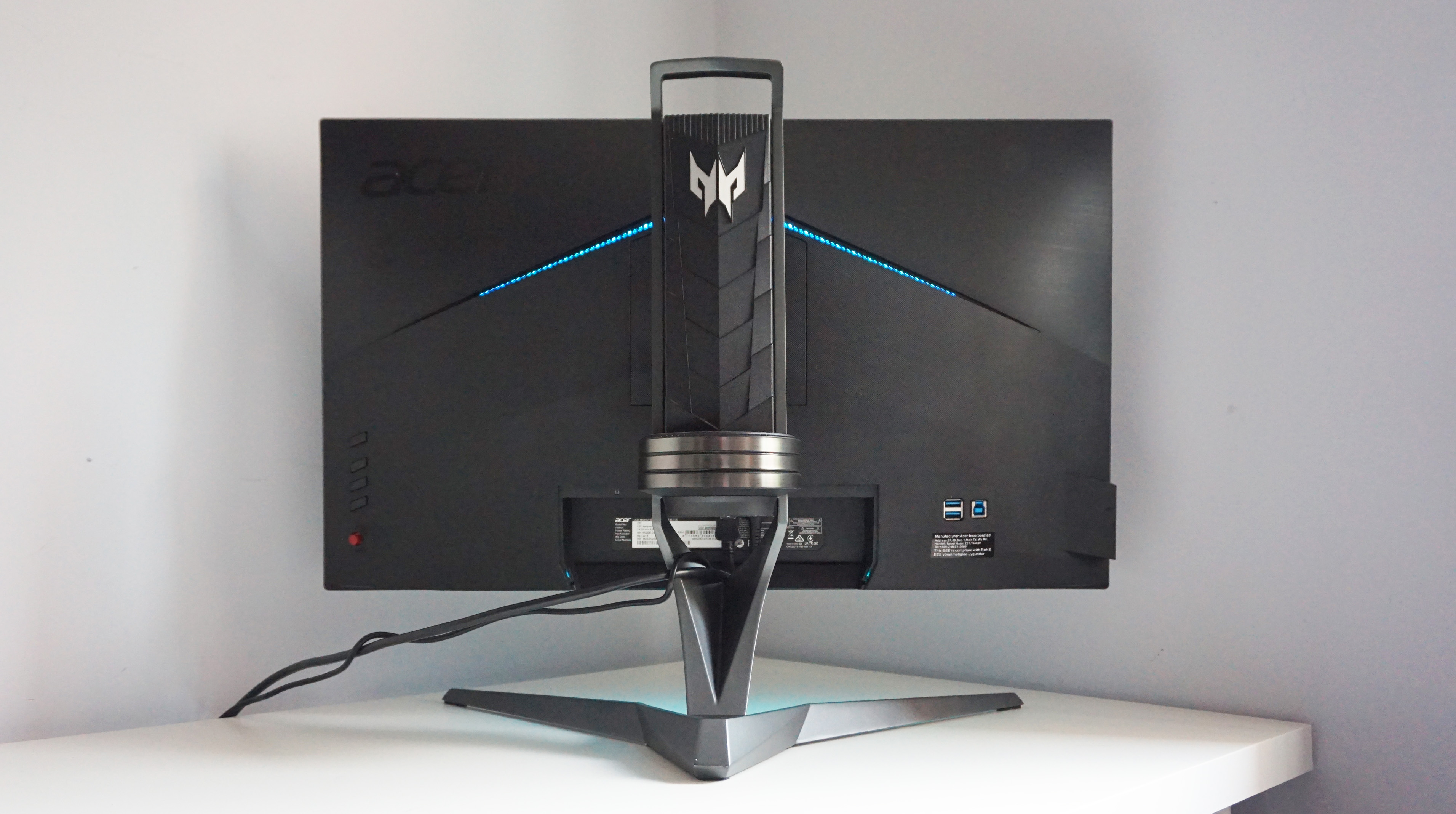
On paper, the Acer Predator X27 must be the bestest best gaming monitor to finish all gaming screens. It’s received the identical beautiful 4K 144Hz IPS Nvidia G-Sync HDR panel with 384 dynamic backlight zones and 1000cd/m2 peak brightness because the Asus ROG Swift PG27UQ, however within the UK it prices £200 lower than its Asus rival. That won’t be of a lot comfort to anybody within the US, the place each G-Sync HDR screens value a hoofing an identical $2000 apiece, however once you’re requested to decide on between spending £2300 and £2100 for precisely the identical panel (and I imply precisely the identical), I do know which one I’d moderately select – particularly when the latter doesn’t bombard you with an LED mild present packed into its stand.
There is, nevertheless, a small drawback (all proper, a number of small issues). For starters, it nonetheless prices $2000 / £2100. As I stated in my Asus PG27UQ evaluate, I may most likely justify spending a grand on a flowery monitor like this (simply) – I’d undoubtedly spend as a lot on a flowery Ultra HD Premium TV with HDR and 1000cd/m2 brightness – however greater than double that? On yer bike, mate. Even if I did have that sum of money, although, I simply couldn’t get the Predator X27 to do HDR ranges of brightness and HDR ranges of color, which completely isn’t what you need from a two grand+ monitor. Here’s how I received on.
I’ll preface this by saying the Predator X27 continues to be a really, very good monitor. While I most likely choose the straight strains and barely thicker stand of the Asus PG27UQ, the equally versatile and height-adjustable Predator X27 is unquestionably the least obnoxious of the 2. There’s a sprinkling of LEDs each behind the monitor and throughout the decrease bezel, giving your desk a form of blue underglow like a kind of decked out motors off Pimp My Ride, however at the least it’s higher than having the ROG emblem splattered throughout your desk and ceiling. You can, in fact, flip each units of LEDs off utilizing the onboard menu, however I shortly grew to become fairly keen on the X27’s chilled-out temper lighting and ended up leaving it on.
I’d additionally say the copious followers crammed into the again of the X27 (most likely to forestall its G-Sync HDR gubbins from melting the panel in entrance of it) are maybe a tad simpler on the ears than the PG27UQ, however there’s actually not a lot in it. If something, they’re really worse than the PG27UQ’s followers, as they by no means really swap off. Ever. If you’re planning on placing this display in a room the place you sleep or do something the place the candy sound of blower followers gained’t drive to you to distraction, you’re going to need to unplug this factor from the wall even when it’s turned off and also you’re not utilizing it, as a result of this factor by no means shuts up.

The X27 has a refined LED underglow occurring underneath the decrease bezel, however you’ll be able to at all times flip it off in the event you choose
Noise points apart, the X27 generally is a actual deal with. Or at the least it’s in the event you keep in mind to show off the helpfully-named and undoubtedly by no means complicated ‘SDR Colours sRGB’ choice within the menu, as disabling that is what permits the monitor to show, fairly actually, the total gamut of beautiful HDR (or excessive dynamic vary) stage color.
The distinction is fairly astonishing, too. For instance, after I examined the monitor utilizing its User color profie (which it routinely switches over to the second you make any form of alterations to its Standard, Movie or Eco modes) with SDR Colours sRGB in its default on place, my X-Rite i1 DisplayPro calibrator confirmed the X27 was solely able to displaying 96.2% of the common sRGB color gamut, 67.1% of the significantly bigger and professional-grade Adobe RGB gamut and 69.0% of the all-important DCI-P3 gamut, which is the present commonplace for all HDR-enabled units (see my What is HDR explainer for more information).
That’s fairly respectable for a daily IPS display, however not precisely a ringing endorsement for a monitor that’s threatening to eat your total financial institution stability in a single sitting.
Thankfully, switching the SDR Colours sRGB choice off improved the X27’s color accuracy immeasurably, which moderately raises the query why this choices is even there within the first place. With this turned off, the X27’s sRGB protection shot as much as an ideal 100%, its Adobe RGB leapt to a really spectacular 99.3%, and its DCI-P3 protection hit a really beautiful 93.0%. That’s infinitely higher, you could keep in mind, than the underwhelming 69% DCI-P3 protection I recorded for the PG27UQ, and I believed, ‘Brilliant, this is exactly what I was hoping to see from a two grand gaming display.’
In the PG27UQ’s defence, I’ve since been informed there was, actually, a really related setting hidden someplace within the depths of Asus’ onboard menu system that supposedly did a really related factor to SDR Colour sRGB choice on the X27, which might be why the color accuracy outcomes I received for that one had been a lot decrease. I solely received informed about this after the monitor had been whisked away elsewhere, nevertheless, and I’ve but to get one again in to retest it. Needless to say, although, it completely boggles the thoughts that each screens successfully come crippled straight out of the field with reference to color accuracy, and that neither of them have sufficiently clear menu settings to assist rectify their initially lacklustre gamuts.
Alas, the euphoria of abruptly greener greens, redder reds and bluer blues didn’t final lengthy in any respect. For as quickly as I turned on HDR in Windows 10, these lush, vibrant colors I’d simply clapped eyes on in all of my take a look at photographs successfully when straight again to what they seemed like when SDR Colours sRGB was turned on. Its sRGB gamut protection got here in at 96.6% once more, Adobe RGB at 68.3% and DCI-P3 a mediocre 70.6%.
Now, admittedly, my testing software program doesn’t produce its personal HDR metadata, so the monitor wouldn’t recognise my take a look at patterns as correct HDR content material anyway. As such, these specific exams won’t ever be a totally correct illustration of what the monitor can really do.
HDR games, alternatively, do have their very own HDR metadata, and I hoped in opposition to all hope that this shift in vibrancy and muting of colors on my desktop and take a look at photographs may simply be a bizarre quirk to do the best way HDR is applied on Windows 10 (which, let’s face it, continues to be a complete mess regardless of its current enhancements).
Sadly, this wasn’t the case in any respect. Don’t get me incorrect. Watching a correct 1000cd/m2 (if not nearer to 1100-1200cd/m2, in keeping with my calibrator) energy dawn peak over the mountaintops of Assassin’s Creed Odyssey is completely beautiful. The sheer depth of the sunshine and its juxtaposition in opposition to the game’s dimmer, pre-dawn environment (aided in no small half by the monitor’s excellent distinction ratio of 5962:1, glorious black stage of 0.09cd/m2 and wider, sustained brightness of round 600-700cd/m2) is simply spectacular. This is the stuff HDR is made for, and the place it actually and figuratively shines the brightest.
The drawback is that I couldn’t get the monitor’s HDR-level brightness working with its HDR-level colors.

The X27 comes with only one HDMI 2.Zero and DisplayPort enter, however there’s additionally a headphone jack and a four-port USB3 hub on the aspect as nicely.
I attempted each attainable mixture of settings within the X27’s menu system, fiddled endlessly with the Assassin’s Creed Odyssey’s personal HDR settings, and nonetheless nothing managed to breed those self same intense colors I noticed with HDR switched off. Whatever the X27 is technically able to reaching, it certain doesn’t appear to be it in keeping with my very own eyeballs.
Take that picture of the Odyssey dawn once more. In HDR, think about a lightweight blazing away within the sky, casting a impartial, however distinctively golden hue throughout the timber and hedges surrounding you. It’s a stunning picture and one you’d most likely be completely pleased with in the event you didn’t know any higher. Switch HDR off, nevertheless, and that very same scene turns into remodeled. That golden mild is changed by the vivid purple of an early daybreak with neighbouring clouds blushing pink, orange and mauve because the solar rises increased into the sky. Yes, you’ve misplaced a few of the eye-searing brightness and sense of distinction, however man alive this is how I need my games to look, not the opposite approach round.
Even smaller particulars just like the purple of Kassandra’s mantle and the blue of the Grecian sky had been richer with HDR turned off, making for a extra pleasing picture total. With it on, Kassandra’s hench outfit simply seemed a tad muted and a bit plain, whereas the sky didn’t appear to be something particular in any respect. If it’s even attainable to explain one other color as being ‘beige’, it might be that.

The X27 has two of its USB3 ports situated on the aspect, whereas the opposite two are on the again.
It’s immensely irritating, because it’s clear the monitor is completely able to displaying virtually the total DCI-P3 color gamut. I do know so as a result of my calibrator stated so. Yet one thing inside it’s clearly stopping it from doing so when HDR is enabled.
To be sure it wasn’t only a uncommon dangerous implementation on Ubisoft’s half (no offence, Ubi), I went via the identical course of with Final Fantasy XV and Forza Horizon 4 as nicely. Sadly, my suspicions had been confirmed right here too. Colours seemed lovely in non-HDR, however a bit ‘meh’ in HDR. Forza Horizon four was, admittedly, the least disappointing of the lot – as a result of gee whiz my coronary heart did somewhat flip flop after I noticed that autumn solar burst throughout the British countryside within the game’s opening sequence – however there was nonetheless an considerable distinction in its total color vibrancy.
It primarily led to a scenario the place I needed to choose between beautiful, vivid colors and lovely brightness. For the sake of my eyes and basic private style, I ended up selecting the colors each time.
It doesn’t assist that just about the entire Predator X27’s image settings are greyed out when HDR is enabled, supplying you with only a few choices to try to rectify it. The traditional, adjustable Brightness setting abruptly turns into a locked down setting referred to as Ref White whose quantity appeared to vary each time I opened the menu, got here out of enjoying a game or just turned the monitor on, whereas Contrast, Dark Boost, Auto Brightness and SDR Colours sRGB additionally turn into unalterable.
About the one factor of use you’ll be able to really change is the color temperature, which I’d already set accurately utilizing its customisable User setting after I calibrated it the primary time (pumping Red and Blue as much as 100 whereas dropping Green all the way down to 90).

To actually give it that ‘professional photographer monitor’ look, the X27 additionally comes with a detachable, screw-on hood for max HDR affect.
It’s a stark distinction from what I keep in mind the Asus ROG Swift PG27UQ trying like with HDR games onscreen (underwhelming measurements apart), however until I get them each sat on my desk aspect by aspect it’s troublesome to say definitively which one really does HDR higher. Technically, they need to each be capable of do it in addition to the opposite – they do, in spite of everything, share the very same panel from the identical producer. In follow, nevertheless, I’d cautiously put my wager on the Asus PG27UQ as a substitute of the X27 – which is rattling annoying when it prices £200 extra.
Hopefully, it gained’t be too lengthy earlier than the PG27UQ wings its approach again to me. Until then, nevertheless, I’d say maintain your horses, as a result of so far as I can inform, the Acer Predator X27 isn’t the miracle monitor I needed it to be.



